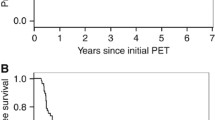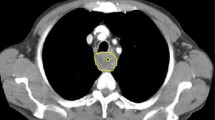Abstract
Purpose
It has been suggested that FDG PET has predictive value for the prognosis of treated oesophageal carcinoma. However, the studies reported in the literature have shown discordant results. The aim of this study was to determine whether pretherapy quantitative metabolic parameters correlate with patient outcomes.
Methods
Included in the study were 67 patients with a histological diagnosis of oesophageal squamous cell carcinoma. Each patient underwent 18F-FDG PET (4.5 MBq/kg) before chemoradiotherapy. Quantitative analysis was performed using the following parameters: age, weight loss, location, N stage, OMS performance status, MTVp and MTVp′ (metabolic tumour volume determined by two different physicians), MTV40% (volume for a threshold of 40 % of SUVmax), MTVa (volume automatically determined with a contrast-based adaptive threshold method), SUVmax, SUVmean and TLG (total lesion glycolysis).
Results
MTVp and MTV40% were highly correlated (Pearson’s index 0.92). SUVmeanp and SUVmean40% were also correlated (Pearson’s index 0.86), as were TLGp and TLG40% (Pearson’s index 0.98). Similarly, the parameters obtained with the adaptive threshold method (MTVa, SUVmeana and TLGa) were correlated with those obtained manually (MTVp, SUVmeanp and TLGp). The manual metabolic tumour volume determination (MTVp and MTVp′) was reproducible. Multivariate analysis for disease-free survival (DFS) showed that a larger MTVp was associated with a shorter DFS (p = 0.004) and that a higher SUVmax was associated with a longer DFS (p = 0.02). Multivariate analysis for overall survival (OS) showed that a larger MTVp was associated with a shorter OS (p = 0.01) and that a tumour in the distal oesophagus was associated with a longer OS (p = 0.005). The associations among the other parameters were not statistically significant.
Conclusion
Metabolic tumour volume is a major prognostic factor for DFS and OS in patients with oesophageal squamous cell carcinoma. Higher SUVmax values were paradoxically associated with longer survival. The location of the tumour also appeared to affect prognosis.



Similar content being viewed by others
References
Pennathur A, Gibson MK, Jobe BA, Luketich JD. Oesophageal carcinoma. Lancet. 2013;381:400–12.
Zhang Y. Epidemiology of esophageal cancer. World J Gastroenterol. 2013;19:5598–606.
Institut National du Cancer. La situation du cancer en France en 2010. Collection Rapports & synthèses. Boulogne-Billancourt: INCa; novembre 2010.
Enzinger PC, Mayer RJ. Esophageal cancer. New Engl J Med. 2003;349:2241–52.
Bedenne L, Michel P, Bouché O, Milan C, Mariette C, Conroy T, et al. Chemoradiation followed by surgery compared with chemoradiation alone in squamous cancer of the esophagus: FFCD 9102. J Clin Oncol. 2007;25:4025–6.
Van Westreenen HL, Westerterp M, Bossuyt PMM, Pruim J, Sloof GW, van Lanschot JJB, et al. Systematic review of the staging performance of 18F-fluorodeoxyglucose positron emission tomography in esophageal cancer. J Clin Oncol. 2004;22:3805–12.
Van Vliet EP, Heijenbrok-Kal MH, Hunink MG, Kuipers EJ, Siersema PD. Staging investigations for oesophageal cancer: a meta-analysis. Br J Cancer. 2008;98:547–57.
Downey RJ, Akhurst T, Ilson D, Ginsberg R, Bains MS, Gonen M, et al. Whole body 18FDG-PET and the response of esophageal cancer to induction therapy: results of a prospective trial. J Clin Oncol. 2003;21:428–32.
Omloo JM, van Heijl M, Hoekstra OS, van Berge Henegouwen MI, van Lanschot JJ, Sloof GW. FDG-PET parameters as prognostic factor in esophageal cancer patients: a review. Ann Surg Oncol. 2011;18:3338–52.
Van de Wiele C, Kruse V, Smeets P, Sathekge M, Maes A. Predictive and prognostic value of metabolic tumour volume and total lesion glycolysis in solid tumours. Eur J Nucl Med Mol Imaging. 2013;40:290–301.
Di Fiore F, Blondin V, Hitzel A, Edet-sanson A, Benyoucef A, Huet E, et al. 18F-fluorodeoxyglucose positron emission tomography after definitive chemoradiotherapy in patients with oesophageal carcinoma. Dig Liver Dis. 2012;44:875–9.
Touboul E, Huguet F, Talbot J-N. Use of PET for staging, treatment evaluation, and follow-up in esophageal cancers. Cancer Radiother. 2008;12:633–9.
Kwee RM. Prediction of tumor response to neoadjuvant therapy in patients with esophageal cancer with use of 18F FDG PET: a systematic review. Radiology. 2010;254:707–17.
Palie O, Michel P, Ménard J-F, Rousseau C, Rio E, Bridji B, et al. The predictive value of treatment response using FDG PET performed on day 21 of chemoradiotherapy in patients with oesophageal squamous cell carcinoma. A prospective, multicentre study (RTEP3). Eur J Nucl Med Mol Imaging. 2013;40:1345–55.
Wieder HA, Brücher BL, Zimmermann F, Becker K, Lordick F, Beer A, et al. Time course of tumor metabolic activity during chemoradiotherapy of esophageal squamous cell carcinoma and response to treatment. J Clin Oncol. 2004;22:900–8.
Blom RL, Steenbakkers IR, Lammering G, Vliegen RF, Belgers EJ, de Jonge C, et al. PET/CT-based metabolic tumour volume for response prediction of neoadjuvant chemoradiotherapy in oesophageal carcinoma. Eur J Nucl Med Mol Imaging. 2013;40:1500–6.
Hyun SH, Choi JY, Shim YM, Kim K, Lee SJ, Cho YS, et al. Prognostic value of metabolic tumor volume measured by 18F-fluorodeoxyglucose positron emission tomography in patients with esophageal carcinoma. Ann Surg Oncol. 2010;17:115–22.
Mamede M, Abreu-E-Lima P, Oliva MR, Nosé V, Mamon H, Gerbaudo VH. FDG-PET/CT tumor segmentation-derived indices of metabolic activity to assess response to neoadjuvant therapy and progression-free survival in esophageal cancer: correlation with histopathology results. Am J Clin Oncol. 2007;30:377–88.
Hatt M, Visvikis D, Pradier O, Cheze-le RC. Baseline 18F-FDG PET image-derived parameters for therapy response prediction in oesophageal cancer. Eur J Nucl Med Mol Imaging. 2011;38:1595–606.
Zhu W-Q, Sun X, Xing L, Li M, Yue J, Qu W, et al. Oesophageal squamous cell carcinoma: relationship between fluorine-18 fludeoxyglucose positron emission tomography CT maximum standardised uptake value, metabolic tumour volume, and tumour, node and metastasis classification. Br J Radiol. 2012;85:e383–7.
Herskovic A, Russell W, Liptay M, Fidler MJ, Al-Sarraf M. Esophageal carcinoma advances in treatment results for locally advanced disease: review. Ann Oncol. 2012;23:1095–103.
Vauclin S, Doyeux K, Hapdey S, Vera P. Development of a generic thresholding algorithm for the delineation of 18FDG-PET-positive tissue: application to the comparison of three thresholding. Phys Med Biol. 2009;54:6901–16.
Roedl JB, Halpern EF, Colen RR, Sahani DV, Fischman AJ, Blake MA. Metabolic tumor width parameters as determined on PET/CT predict disease-free survival and treatment response in squamous cell carcinoma of the esophagus. Mol Imaging Biol. 2009;11:54–60.
Fencl P, Belohlavek O, Harustiak T, Zemanova M. The analysis of factors affecting the threshold on repeated 18F-FDG-PET/CT investigations measured by the PERCIST protocol in patients with esophageal carcinoma. Nucl Med Commun. 2012;33:1188–94.
Créhange G, Bosset M, Lorchel F, Fabrice L, Buffet-Miny J, Dumas JL, et al. Tumor volume as outcome determinant in patients treated with chemoradiation for locally advanced esophageal cancer. Am J Clin Oncol. 2006;29:583–7.
Hatt M, Visvikis D. Prognostic value of 18F-FDG PET image-based parameters in oesophageal cancer and impact of tumour delineation methodology. Eur J Nucl Med Mol Imaging. 2011;38:1191–202.
Levine EA, Farmer MR, Clark P, Mishra G, Ho C, Geisinger KR, et al. Predictive value of 18-fluoro-deoxy-glucose-positron emission tomography (18F-FDG-PET) in the identification of responders to chemoradiation therapy for the treatment of locally advanced esophageal cancer. Ann Surg. 2006;243:472–8.
Gerdes J, Lemke H, Baisch H, Wacker H, Schwab U, Stein H. Cell cycle analysis of a cell proliferation-associated human nuclear antigen defined by the monoclonal antibody Ki-67. Eur J Cancer. 1984;133:1710–5.
Yamamoto Y, Nishiyama Y. Correlation of 18F-FLT and 18F-FDG uptake on PET with Ki-67 immunohistochemistry in non-small cell lung cancer. Eur J Nucl Med Mol Imaging. 2007;34:1610–6.
Vesselle H, Schmidt RA, Pugsley JM, Li M, Kohlmyer SG, Vallires E, et al. Lung cancer proliferation correlates with [F-18]fluorodeoxyglucose uptake by positron emission tomography. Clin Cancer Res. 2000;6:3837–44.
Murakami S, Saito H, Sakuma Y, Mizutani Y, Ishikawa Y, Ito H, et al. Correlation of 18F-fluorodeoxyglucose uptake on positron emission tomography with Ki-67 index and pathological invasive area in lung adenocarcinomas 30 mm or less in size. Eur J Radiol. 2010;75:e62–6.
Han B, Lin S, Yu L, Wang R, Wang Y. Correlation of 18F-FDG PET activity with expressions of survivin, Ki67, and CD34 in non-small-cell lung cancer. Nucl Med Commun. 2009;30:831–7.
Sueta A, Yamamoto Y, Hayashi M, Yamamoto S. Clinical significance of pretherapeutic Ki67 as a predictive parameter for response to neoadjuvant chemotherapy in breast cancer; is it equally useful across tumor subtypes? Surgery. 2011;155:927–35.
Petit T, Wilt M, Velten M, Millon R, Rodier J, Borel C. Comparative value of tumour grade, hormonal receptors, Ki-67, HER-2 and topoisomerase II alpha status as predictive markers in breast cancer patients treated with neoadjuvant anthracycline-based chemotherapy. Eur J Cancer. 2004;40:205–11.
Pohl G, Rudas M, Taucher S, Stranzl T, Steger GG, Jakesz R, et al. Expression of cell cycle regulatory proteins in breast carcinomas before and after preoperative chemotherapy. Breast Cancer Res Treat. 2003;78:97–103.
Yam P-C, Tong D, Law S. Comparisons of sixth and seventh edition of the American Joint Cancer Committee staging systems for esophageal cancer. Ann Surg Oncol. 2013;21:583–8.
Wu N, Chen Z, Pang L, Ma Q, Chen G. Prognostic significance of lymph node characteristics on survival in esophageal squamous cell carcinomas. Wien Klin Wochenschr. 2013;125:26–33.
Situ D, Wei W, Lin P, Long H, Zhang L, Fu J, et al. Do tumor grade and location affect survival in esophageal squamous cell carcinoma? Survival analysis of 302 cases of pT3N0M0 esophageal squamous cell carcinoma. Ann Surg Oncol. 2013;20:580–5.
Bashash M, Hislop TG, Shah AM, Le N, Brooks-Wilson A, Bajdik CD. The prognostic effect of ethnicity for gastric and esophageal cancer: the population-based experience in British Columbia, Canada. BMC Cancer. 2011;11:164.
Eloubeidi MA, Desmond R, Arguedas MR, Reed CE. Prognostic factors for the survival of patients with esophageal carcinoma in the U.S. The importance of tumor length and lymph node status. Cancer. 2002;95:1434–43.
Makris NE, Huisman MC, Boellaard R. Evaluation of strategies towards harmonization of FDG PET/CT studies in multicentre trials: comparison of scanner validation phantoms and data analysis procedures. Eur J Nucl Med Mol Imaging. 2013;40:1507–15.
Acknowledgments
This study was partially supported by a grant from the Ligue Contre le Cancer de Haute Normandie and the North West Canceropole (National Cancer Institute - INCa).
Conflicts of interest
None.
Author information
Authors and Affiliations
Corresponding author
Rights and permissions
About this article
Cite this article
Lemarignier, C., Di Fiore, F., Marre, C. et al. Pretreatment metabolic tumour volume is predictive of disease-free survival and overall survival in patients with oesophageal squamous cell carcinoma. Eur J Nucl Med Mol Imaging 41, 2008–2016 (2014). https://doi.org/10.1007/s00259-014-2839-y
Received:
Accepted:
Published:
Issue Date:
DOI: https://doi.org/10.1007/s00259-014-2839-y




